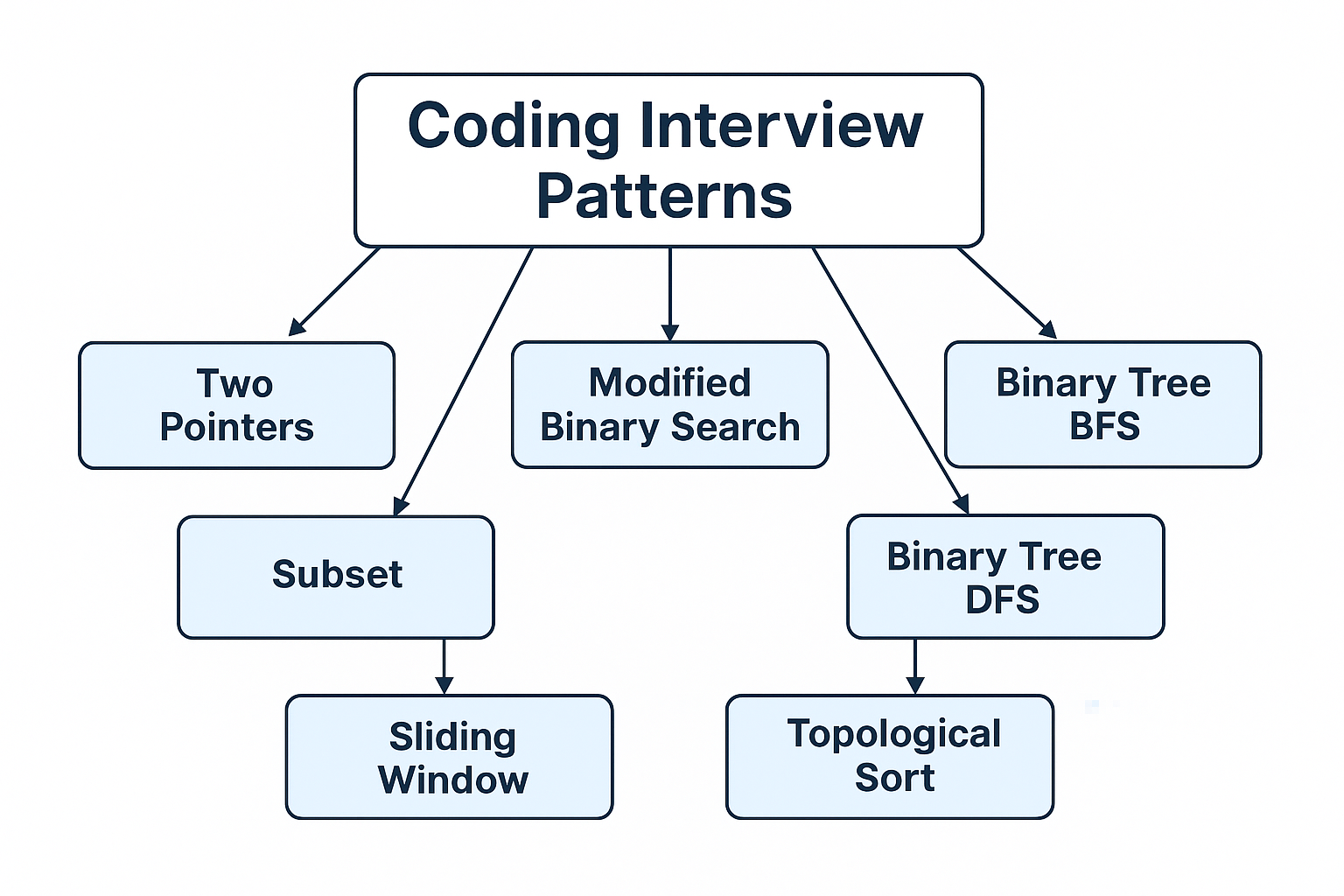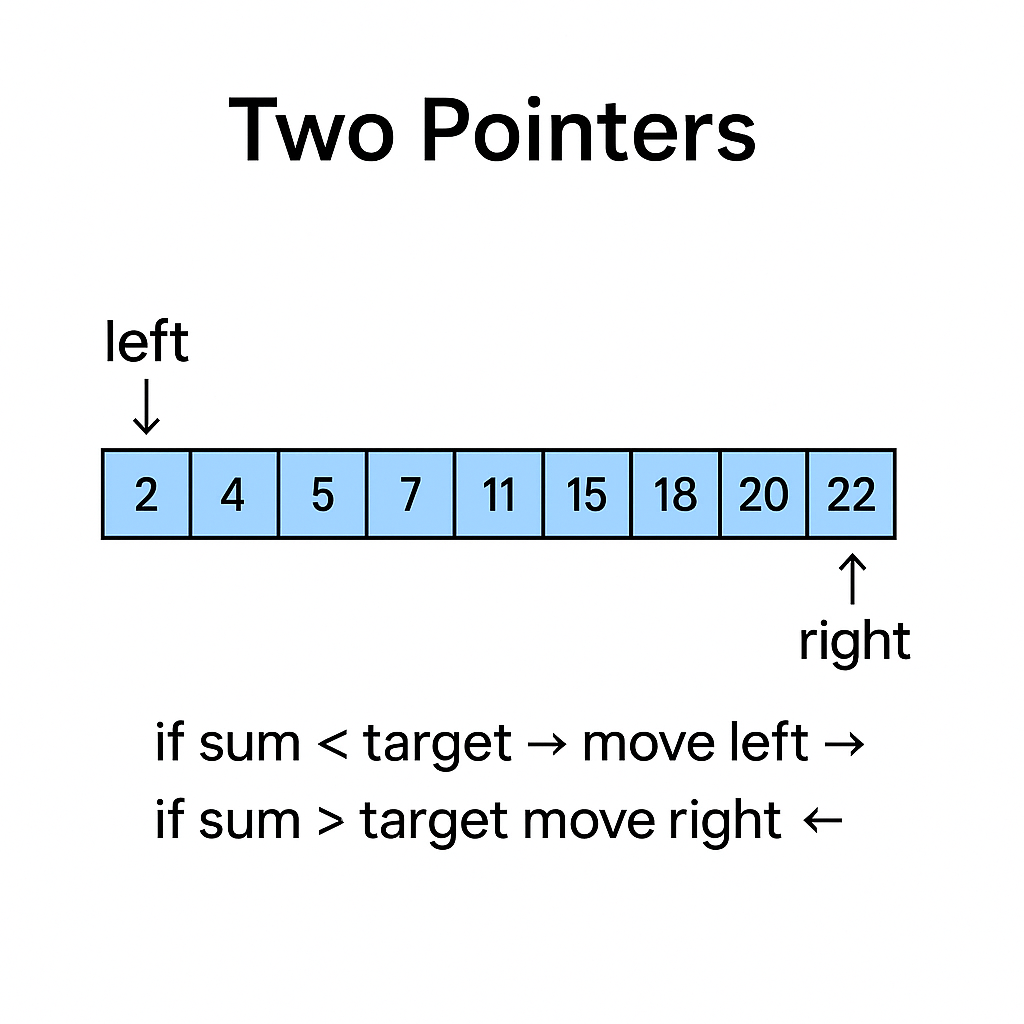
Coding Interview Patterns: 8 Must-Know Techniques for Success (2025 Guide)
Coding interview patterns are the key to cracking technical interviews at top tech companies. In this guide, you’ll quickly review 8 essential ones in 5 minutes.
Summary:
This blog is your 5-minute last-minute revision sheet covering 8 essential coding patterns that consistently appear in top tech interviews. From two pointers to topological sort, this is the ultimate quick review before your next technical round.
Table of Contents
🧠 Introduction to Coding Interview Patterns
Before walking into a technical interview, it’s crucial to quickly revise common problem-solving patterns. These 8 coding interview patterns form the backbone of FAANG-style DSA questions and are a must-know for any serious candidate.
This is nothing but quick 5 min revision before going to interview.
1. Two Pointers – A Core Coding Interview Pattern

Core Concept:
- Use two indices (pointers) to scan through a data structure (usually an array or linked list).
- Move pointers inward based on the problem condition.
- Common setup:
left = 0right = len(arr) - 1
📋 When to Use:
- Array is sorted
- Looking for pairs or triplets
- In-place operations
- Merging or comparing values
✅ Common Use Cases:
| Problem Type | Description |
|---|---|
| Pair Sum / Target Sum | Move inward based on sum comparison |
| Palindrome Check | Compare characters from both ends |
| Container With Most Water | Maximize area between two heights |
| Remove Duplicates | Use slow/fast pointers |
| Sorted Squares | Insert squares from ends to result |
🔁 Strategy Variants:
- Start-End Pointers (e.g.,
left,right) - Slow-Fast Pointers (used in cycle detection, linked lists)
- Multiple arrays/pointers (e.g., merging two arrays)
⚠️ Pitfalls to Avoid:
- Forgetting to update pointers → infinite loop
- Not checking
left <= rightcondition - Wrong direction of movement based on logic
🧪 Practice Questions
Level: Easy – Good for Top Interview Prep
- Two Sum II – Input array is sorted
- Valid Palindrome
- Move Zeroes
🔍 2. Modified Binary Search
🧠 Core Concept:
Apply binary search on non-traditional conditions like rotated arrays, peaks, or specific occurrences.
📋 When to Use:
- The array is not fully sorted, but follows some structure (rotated, bitonic, etc.)
- Need to find first/last occurrence
- Binary logic can reduce search space
✅ Common Use Cases:
| Problem Type | Description |
|---|---|
| Search in Rotated Array | Adjust mid pointer by comparing with ends |
| Peak Index in Mountain Array | Find local maxima using mid comparisons |
| First/Last Occurrence | Adjust search range based on target comparison |
⚠️ Pitfalls to Avoid:
- Off-by-one errors (mid calculation)
- Not updating search boundaries correctly
- Forgetting to check sorted halves
🧪 Practice Questions:
- Search in Rotated Sorted Array
- Peak Index in a Mountain Array
- First Bad Version
🔄 3. Sliding Window
🧠 Core Concept:
Maintain a fixed-size or dynamic-sized window and slide it over data to track a subarray/substring.
📋 When to Use:
- Find max/min/average over a window
- Longest/shortest subarray with condition
- Character frequency in a substring
✅ Common Use Cases:
| Problem Type | Description |
|---|---|
| Max Sum Subarray | Fixed-size window to track max sum |
| Longest Substring w/o Repeat | Expand window until duplicate, then shrink |
| Min Window Substring | Grow-shrink window until condition is met |
⚠️ Pitfalls to Avoid:
- Not shrinking window correctly
- Mismanaging frequency maps
- Missing edge cases with empty or full windows
🧪 Practice Questions:
- Maximum Average Subarray I
- Longest Substring Without Repeating Characters
- Minimum Window Substring
🔁 4. Fast and Slow Pointers (Cycle Detection)
🧠 Core Concept:
Move two pointers at different speeds to detect cycles, midpoints, or intersection points in linked structures.
📋 When to Use:
- Cycle detection in linked lists
- Finding middle node
- Detecting intersection point of two linked lists
✅ Common Use Cases:
| Problem Type | Description |
|---|---|
| Detect Cycle | Slow = 1 step, Fast = 2 steps |
| Find Cycle Start | Reuse slow pointer logic |
| Find Middle of List | Fast reaches end while slow reaches middle |
⚠️ Pitfalls to Avoid:
- Fast pointer may become nil → check before accessing
fast.next - Infinite loop if cycle isn’t handled properly
🧪 Practice Questions:
- Linked List Cycle
- Find the Duplicate Number
- Middle of the Linked List
🧱 5. Prefix Sum
🧠 Core Concept:
Precompute running sums to quickly answer range-based or cumulative queries.
📋 When to Use:
- Frequent range sum or difference queries
- Count of subarrays with a specific property (e.g., sum = K)
✅ Common Use Cases:
| Problem Type | Description |
|---|---|
| Subarray Sum Equals K | Use hash map with prefix counts |
| Range Sum Query | Precompute prefix sums |
| Max Subarray Sum | Kadane’s algorithm uses running sum |
⚠️ Pitfalls to Avoid:
- Off-by-one errors with indices
- Not initializing prefix map correctly
🧪 Practice Questions:
- Subarray Sum Equals K
- Range Sum Query – Immutable
- Continuous Subarray Sum
🌊 6. Two Heaps (Median of Stream)
🧠 Core Concept:
Use two heaps (min-heap and max-heap) to keep track of dynamic median or balanced partitions.
📋 When to Use:
- Need to find median in a stream
- Need to maintain order statistics dynamically
✅ Common Use Cases:
| Problem Type | Description |
|---|---|
| Find Median from Stream | Balance numbers in two heaps |
| Sliding Window Median | Insert/delete while maintaining balance |
⚠️ Pitfalls to Avoid:
- Forgetting to rebalance heaps
- Not handling even vs odd size correctly
🧪 Practice Questions:
- Find Median from Data Stream
- Sliding Window Median
🗂 7. Merge Intervals
🧠 Core Concept:
Sort intervals and merge overlapping ones based on comparison of end/start times.
📋 When to Use:
- Intervals are involved (time ranges, ranges of numbers)
- Need to find union, intersection, or gaps
✅ Common Use Cases:
| Problem Type | Description |
|---|---|
| Merge Intervals | Merge based on overlapping conditions |
| Insert Interval | Add and merge in-place |
| Meeting Rooms | Count overlaps to schedule rooms |
⚠️ Pitfalls to Avoid:
- Not sorting by start time
- Overlapping condition not handled properly
🧪 Practice Questions:
- Merge Intervals
- Insert Interval
- Meeting Rooms II
🔁 8. Monotonic Stack
🧠 Core Concept:
Use a stack to maintain monotonically increasing or decreasing order, useful for next greater/smaller element problems.
📋 When to Use:
- Find Next Greater Element
- Handle Histogram / Span problems
- Backtracking of previous greater/smaller
✅ Common Use Cases:
| Problem Type | Description |
|---|---|
| Next Greater Element | Track decreasing order with stack |
| Daily Temperatures | Use stack to find warmer future day |
| Largest Rectangle in Histogram | Track heights and widths via stack |
⚠️ Pitfalls to Avoid:
- Not handling empty stack checks
- Infinite loop if elements not popped correctly
🧪 Practice Questions:
- Next Greater Element I/II
- Daily Temperatures
- Largest Rectangle in Histogram
Here’s a quick recap of each pattern with sample problems:
| Pattern | Sample Questions |
|---|---|
| Two Pointers | Valid Palindrome, Two Sum II |
| Binary Search | Peak Index, Rotated Sorted Array |
| BFS | Level Order Traversal, Min Depth |
| DFS | Path Sum, Diameter of Tree |
| Topological Sort | Course Schedule |
| Top K Elements | Kth Largest, Top K Frequent |
| Subset | Subsets, Combination Sum |
| Sliding Window | Longest Unique Substring, Max Sum Window |
🎯 Conclusion
These 8 patterns give you a framework to think during interviews. Don’t just memorize solutions—practice these patterns using top problems from Leetcode, GeeksforGeeks, or Code & Algo.
- “These coding interview patterns are commonly asked in Google, Meta, and Amazon interviews.”
- “Mastering coding interview patterns is key to solving unseen problems quickly.”
- “You’ll see these coding interview patterns repeated in platforms like LeetCode and HackerRank.”
- “By practicing these coding interview patterns, you build intuition over time.”
- “Don’t just memorize problems—learn the patterns behind each solution.”
🔗 Explore More
For additional practice problems, check out LeetCode Explore.
👉 Visit CodeAndAlgo.com for more system design breakdowns, coding pattern guides, and interview strategies.